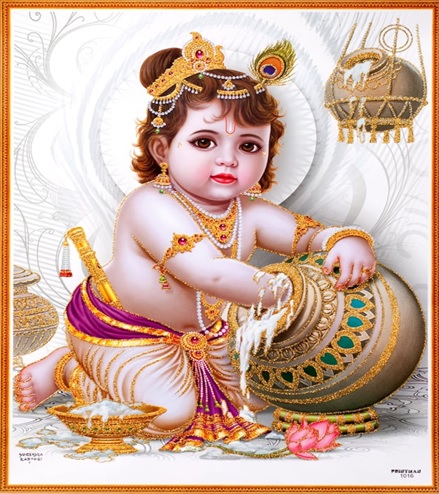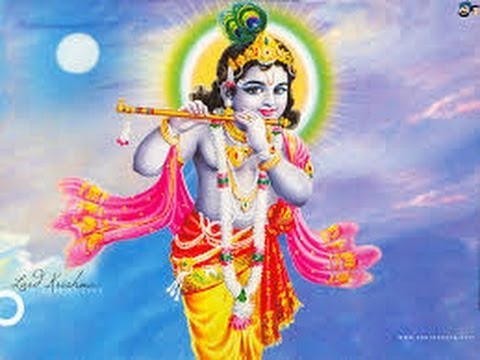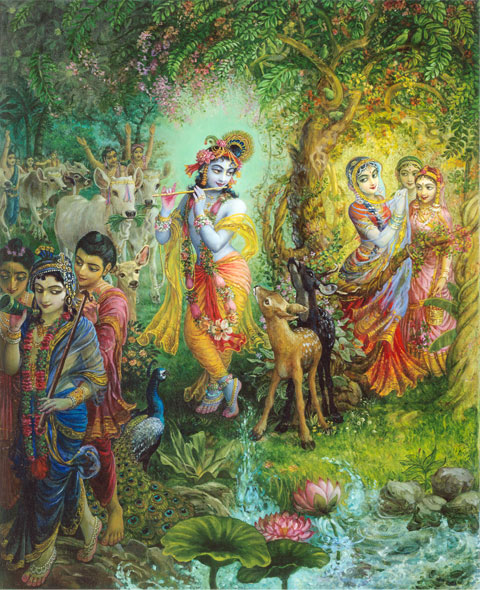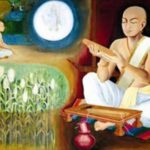The following Post continues our Series on Narasaraju garu’s Book on Bhagavatamu
Continuing our Series of Articles on the translation of Telugu Bhagavatam by Professor T.S.B. Narasaraju of Banaras Hindu University, is Excerpt II. Those interested in reading Excerpt I of our series can find it here.
This installment will cover the Author’s Preface, a brief intro on Pothana Mahakavi, and provide selections from the Original Work itself.
Publishers interested in printing or offering e-Publication of Narasaraju garu’s work can reach him via email at shamraan@gmail.com
Click here to download Part I of the English Translation of Potana’s Bhagavata Purana (Dasama Skandha)
Part II can be found below at the end of the article and is also available for free.
chetularanga sivuni pujimpadeni
norunovvanga hari kirthi nuduvadeni
dayayu satyambu lonuga talupadeni
kaluganetiki tallula kadupuchetu
If Lord Siva is not worshipped by one with folded
hands till the hands ache, Lord Hari`s glory is not
sung in full throat till it chokes, kindness towards
others and righteousness are not cultivated by one,
giving such a birth is a curse to the mother
[Excerpt. Some emphasis ours.]
Copyright: T.S.B.Narasaraju. All rights reserved. 2017.
Preface
Bhagavata Purana is one among eighteen Puranas written by sage Vyasa in Sanskrit. Puranas are accounts of births and deeds of Hindu gods.The literal definition of a Purana is that which remains new perennially. Bhagavata Purana emphasizes the path of devotion to the lord by describing his sterling qualities and incarnations. It was first taught by Vyasa to his son, Suka. Being requested by Parikshit tormented by an impending death by the bite of a serpent, Suka recited Bhagavata Purana enabling Parikshit to attain salvation.
Being the most prominent among the Puranas, Bhagavata Purana underwent translations into several other languages. Its translation into Telugu by Potana is one such. It is believed that Potana was born and spent his life in a village called Bammera located in the present Telangana State during the fifteenth century. He wrote the work there motivated by the appearance and command of lord Rama of whom he was an ardent devotee.
Potana’s Bhagavata Purana continues to remain close to the hearts of Telugu-speaking people since the concept of Mathura Bhakti, one of several recommended methods of devotion to the lord, is competently illustrated by him in the work through simple and sweet vocabulary. His work has been embedded with a rhythmic and a delightful combination of vocabulary to make the readers recite its verses over and over again in a devotional ecstasy. Potana`s Bhagavata Purana continues to influence a large section of Telugu population to imbibe a spiritual thinking, a devotional involvement and a principled living.
It is believed that Telugu has been in use ever since the commencement of the Christian era. However, prominent literary works in Telugu emerged only from the middle of eleventh century C. E. The earliest significant work was a translation of Mahabharata from Sanskrit, like other works which followed. Consequently, this period of Telugu literature is known as Anuvada Yuga, an era of translations.
The mode of translation followed can be divided into three types: (i) Swatantra Anuvada or Kathanuvada, (ii) Bhava-anuvada and (iii) Yatha-tadha-anuvada.The first mode of translation was adopted by the famous Kavitraya, the three famous Telugu literary personalities, Nannaya,Tikkana and Yerrapragada in the translation of Mahabharata. Here the translator enjoys the liberty of additions and deletions of the original work adhering at the same time to the story of the original. In the second type followed by Srinatha, another towering Telugu literary personality of the distant past, in the translation of Nyshadha,written in Sanskrit by Harsha, only the essence of the original is reproduced.The third type, followed principally for the translation of dramas, is a true reproduction of the original including the usage of the same vocabulary, being a literal counterpart of the one used in the original. Potana followed a judicious combination of types (i) and (ii) being motivated by the Kavitraya and Srinatha. Being a strong devotee of the lord he elaborated extensively the devotional sequences departing from the original. Potana, in addition to his devotion to the lord, was a great scholar and a poet of exllence. His Bhagavata Purana contained stanzas of all categories of Telugu poetry. It is mentioned by Potana in his Bhagavata Purana that he had a transcendental experience of the appearance of lord Rama and his consort Sita commanding him to translate Vyasa’s Bhagavata Purana into Telugu to free himself from the mundane terrestrial bonds to get salvation. That experience seemed to have transformed the natural poetic ability of Potana into an ecstatic state of mind which resulted in his version of Bhagavata Purana which makes a studious and devoted reader of the work wonder whether at all a human mind can attain such levels of excellence once again.
Potana`s literary prowess is believed to be a divine gift. He says that some among the likely readers of his work have a bias for Telugu while others have a liking for Sanskrit. He prefers to adopt a judicious combination of the two languages in his Bhagavata Purana, a luxury which he could afford because of his proficiency in both the languages. According to Potana`s philosophy activities devoid of devotion to god are totally futile.
The Dasama Skandha,Tenth Canto of Bhagavata Purana, is different from others, being a complete and a competent account of the different facets of Krishna Avatara, an incarnation of lord Krishna. He is considered to be the primordial incarnation of lord Vishnu, who appeared in the form of other Avataras. Bhagavata Purana is considered to be an embodiment of lord Vishnu himself with its twelve cantos as the different organs of the lord.The significance of Dasama Skandha is evident from the fact that it is considered to be the face of the lord and is therefore distinct from the other cantos. It is the biggest among the cantos of Bhagavata Purana spreading over three thousand verses and pieces of prose.
The writer of the present translation of Dasama Skandha of Potana`s Bhagavata Purana into English has no pretensions about his competence to undertake the work since he spent a major part of his life of about eight decades in studying, teaching and guiding research in Chemistry at a couple of Central Universities, namely, Banaras Hindu University,Varanasi and North-Eastern Hill University, Shilling.A tenure of about four decades, his entire professional career, was consequently spent away from Andhra Pradesh as a Pravasa Andhra. He could thus realize the disadvantage inflicted by him on his son and daughter, as well as by his intimate Telugu colleagues on their children, by alienating them from an exposure to even rudimentary aspects of Telugu literature for no fault of the youngsters. The same sentiment is applicable to a big chunk of contemporary Telugu-speaking people scattered all over the globe consequent upon professional compulsions.
Being motivated probably by an over-ambitious feeling that he is capable of writing a comprehensible English, the author ventured to do Yadha-tadha anuvada into English of Dasama Skandha of Potana`s Bhagavata Purana which has been very close to his heart right from his days of higher secondary education in Veeresalingam High School, Rajahmahendravaram, a place of Adi Kavi Nannaya. His audacity to attempt this work was to a large extent motivated by the fact that selected portions of Dasama Skandha of Potana`s Bhagavata Purana were taught to him by an illustrious Telugu literary personality of the recent past, namely the late Sri Madhunapantula Satyanarayana Sastri, the then member of the teaching staff of the high school in which the author studied, to whom the author wants to express his homage and gratitude. The present attempt is primarily intended to expose the Pravasa Andhra adolescents, not knowing written Telugu, who may read this work, to the nuances of Potana`s Bhagavata Purana, an opportunity denied to them by their parents, for which the youngsters are not to be blamed.
The author is not apologetic about his truncated level of comprehension of Bhagavata Purana since Potana himself says in his work that a complete understanding of the work is beyond the capability of any one. The greatness of this Purana is such that even a negligible level of understanding benefits the one who makes an attempt. In order to avoid inconvenience in typing, no transliteration is followed in the present work since the clientele is supposed to be familiar with pronunciation of the Sanskrit words of the work given in italics.The present translation has been divided into three parts to avoid unwieldiness. Part I consists of events ranging from Krishnavatara to lifting of Goverdhanagiri while Part II includes events ranging from Rasakrida to Rukmini Kalyana. The remaining events of Dasama Skandha ranging from Narakasuravadha to Subhadra Parinaya come under Part III of the present work.
Miscellaneous short-comings of the author in understanding some of the usages of Potana are adequately compensated by referring to a few illustrious relevant publications of TTD Religious Publication Series, Tirupati, Potti Sriramulu Telugu Viswavidyalayam, Hyderabad, and of Geeta Press, Gorakhpur. In addition, an exposure to the spiritual discourses by illustrious personalities namely, Sri Swamy Chinmayananda, Sri Swamy Ranganathananda, Sri Jagadguru Kripaluji Maharaj, Sri Ganapat Sachchidananda Swamy, Sri Sukhbodhananda Swamy, Sri Sundarachaitnyananda Swamy, Sri Chinna Jeeyar Swamy, Sri Siddheswaraananda Bharathi Swamy and Sri Ravi Shankar and also of Sri Chaganti Koteswara Rao and Sri Samavedam Shanmukha Sarma, among others, transmitted through different TV channels of India, is of extensive guidance to the author. The author desires to place on record his indebtedness and gratefulness to these organisations and personalities for rendering commendable service to the spiritually oriented sections of our community.
T.S.B. Narasaraju
(v) Potana`s Biography
Potana also known as Potaraju was born in a village Bammera located in the Warangal Taluk of the present Telangana State . While the exact year of his birth is not known, he is believed to have lived between 1400 and 1470 C. E. He was born in Kaundinyasa Gotra as the second son of Kesana and Lakkamamba. Their first son was Tippana. That Srinatha, the famous Telugu poet, was Potana`s brother-in-law, has no historical basis. There is evidence to show that Potana had a son by name Kesana named after Potana`s father. Potana`s son seemed to have inherited literary prowess of the father to earn the title, Proudha Saraswati . In fact the literary proficiency seemed to have percolated through the entire progeny of Potana. In addition to Bhagavata Purana, Potana wrote Veerabhadra Vijaya, Bhogini Dandaka and Narayana Sataka.
(vi) Dedication of Potana`s Bhagavata Purana to Almighty
Bammera Potaraju decided to offer his version of Bhagavata Purana to lord Sri Hari for the good of all. By offering , instead , to kings of disrepute in return to gifts such as Dhanadhanya Vastuvahanas and Grihagramadulu, the author feels that he succumbs after death to lord Yama`s punishments. The following is an account of the sentiments of Potana which prompted him to offer his work to the almighty :–
“A great man appeared before my eyes. He was with his consort and comparable to a blue cloud coupled with a lightning. His smile was as pleasant as the moon-light. He wore a bow comparable to the curvatures and beauty of a huge Ganuga tree entwined with creepers. He wore a crown as effulgent as the sun on top of a blue mountain. His eyes were as elegant as the petals of a lotus. He was a broad-chested prominent king of kings.”
He exhorted Potana to translate Vyasa`s Bhagavata Purana into Telugu.
“ What I am going to write is the most sacred Bhagavata Purana. The one who makes me write is Ramachandra Prabhu himself.This writing has the propensity to disentangle me from the family bonds. Therefore I decided to write it. Where is the need to write any other work?
When a complete comprehension of Bhagavata Purana transcends the abilities of even lord Siva and Brahma will it be possible to understand it for an ordinary man like me? Yet I make an attempt to write what I heard about it from scholars and what is understood by me. Because of my good fortune great poets like Nannaya and Tikkana who translated many works from Sanskrit to Telugu left Bhagavata Purana.I translate it into Telugu to sanctify myself.
I offer my version of Bhagavata Purana to lord Gopalakrishna who wears beautiful effulgent garlands, resides in Nandagokula, steals butter and ghee from houses of shepherds, redeems the sorrows of devotees, wins the hearts of Gopakantas and destroys demons such as Trinavarta and Putana. My work is dedicated to Krishna, a lord of exemplary qualities endowed with the grace of lord Siva, a destroyer of demon Banasura, a savior of Gopagopikas from a hail-storm caused by Indra, by lifting the Govardhana mountain, a redeemer of a curse on Yakshas by uprooting a couple of huge trees, a protector of Varnasrama Dharma and a lord capable of obstructing sun`s rays through his Sudarsana Chakra.
I offer my work to the lord who is an embodiment of grace, a counsellor capable of averting the agony of Arjuna to revive his duty consciousness, a protector of the safety of all living beings and a benefactor of his devotees having the sense organs under their control. He could dance playfully on the hood of a serpent, Kaliya, and destroy the army of Jarasandha several times.
The version of Bhagavata Purana written by me is dedicated to the lord who reclines on a serpent, Adishesha, wearing yellow silken garments. He follows justice rigorously in deciding the results of Karma of human beings, resurrects lives of sons of a Brahmin , restores mental peace to an agitated Rukmini, gives happiness to all living beings, exhibits grace to righteous human beings, steals butter from the houses of Gopikas and creates the entire universe.
My Bhagavata Purana is offered to the almighty who is a skillful sole monarch of initiating creation, propagation, protection and destruction of the universe. He taught Vedas to Brahma. Remaining pure and effulgent, he spreads an illusion as a magician showing that the universe created by him engulfed in the Trigunas is real, like the belief of existence of water in a mirage. I adore such a lord who is ever present in my thoughts.”
1.Introduction
Dasama Skandha of Bhagavata Purana is distinct from the other Skandhas since it contains a complete and competent account of the different facets of Krishnavatara. It is therefore considered as Sri Krishna Sarvaswa. Lord Krishna is considered to be the primordial incarnation of the lord who appeared in the form of the other Avataras. Although the appearance of lord Rama and his exhortation to translate Bhagavata Purana into Telugu to be dedicated to lord Rama motivated Potana to take up the sacred mission, he dedicated his work, instead, to lord Krishna conscious of the primordiality of the lord.
Bhagvata Purana is considered to be an embodiment of lord Vishnu, its twelve Chapters or Skandhas being considered as the organs of the lord. The significance of Dasama Skandha is evident from the fact that it is considered to be the face of the lord. Just as Krishnavatara is distinct from the remaining Avataras of the lord, Dasama Skandha is distinct from the other Chapters of Bhagavata Purana.
The story of Krishna is competently described in several other Sanskrit works, the principal among them being Jaya Deva`s Gita Govinda, Leela Suka`s Sri Krishna Karnamruta and Narayana Tirthulu`s Sri Krishna Leelatarangini, among others. An equally eloquent account of lord Krishna in Telugu is provided by Yarrana’s Hari Vamsa and Potana`s Dasama Skandha of his Bhagavata Purana, among others.
Dasama Skandha is the biggest among the Chapters of Bhagavata Purana spreading over three thousand verses and pieces of prose. It is divided into two parts known as Purva Bhaga and Uttara Bhaga. The Telugu titles of principal aspects of the Purva Bhaga are : (Part I): Krisnavatara Ghattam, Kamsuni pampuna Putana yanu Rakshasi Vrepalle ku Chanudenchuta, Sri Krishna Balaramula Balyakreedabhivarnana, Mryudbhakshana, Viswarupa Pradarshanabhivarnanamu, Sri Krishnudu Kaliyamardanamu Gavinchuta, Gopika Vastrapaharanamu, Sri Krishnudu Govardhana Parvatamunettut. (Part II): Rasakreedabhivarnanamu, Kamsuni Pampuna Akrurudu Brindavanamunaku Chanudenchuta, Sri Krishnamurty Madhuranagara Prvesamu Cheyuta, Sri Krishna Balaramulu Chanura Mushtikulanu Vadhinchuta, Sri Krishnudu Kamsuni Vadhinchuta, Muchkunduni Purva Kathabhivarnanamu, Rukmini Kalyana Katha Prarambhamu, and Sri Krishnudu Rukmini Devini Pendliyaduta.among others. The Uttara Bhaga of Bhagavata Purana is constituted, among others, by the Telugu titles : (Part III): Sri Krisnudu Satyabhamatokudanaragi Narakasuruni Vadhinchuta, Naradundu Sri Krishnunito Dharmaraju Rajasuyamu Neraverpumani Chepputa, Pandavulu Sri Krishnuni Yadurkoni Todkoni Povuta, Sri Krishnuni Sahayunduga Bhimundu Jarasandhunito Yudhamu Seyuta, Dharmaraju Chesedi Rajasuyamunandu Sri Krishnudu Sisupaluni Vadhinchuta, Kuchelopakhyanamu, Subhadra Parinayamu, and Parikshittunaku Sukayogi Vishnuseva Prasastyambu Chepputa.
2.Krishna Bringing Nanda from City of Varuna
On a sacred Ekadasi-day Nanda observed fasting and performed Puja of Vishnu. Unmindful of the fact that it was time of demons, he got into river Yamuna to have Dwadasi-bath even before the day-break. Then demon Varuna`s servant took him away to the city of Varuna. Rest of the Gopakas got agitated since they could not find Nanda. They shouted loud to call Balarama and Krishna. The latter could know that his father was deceitfully kidnapped by the servant of Varuna to his land. He reached that land at once (953).
Varuna saw Madhava visiting his place, worshipped him hurriedly, and said obediently, “Oh! Lord! You are kind enough to visit my house. You make the learned happy. You are the lord who makes those rejoicing in your lotus-shaped feet tread a path unattainable to others. A visit by such a lord filled my heart with over-flowing joy. My desires are fulfilled. Obeisance to you makes my life sanctified (954, 955, 956). Oh! Mahatma! Maya, capable of engulfing all the Lokas, is incapable of conquering you and hence remains under your control, you being the lord of lords.Your effulgent form is the donor of good. You rejoice always in protecting the pious-minded. You are the emperor of those virtuous people who possess Tapas as their wealth. I am saluting to such a lord to free myself from the bodily turmoils (957).You are a role-model in devotion to one`s father ! Your devotees with pure hearts are dear to you ! Without even an iota of intelligence my servant brought your father here. Kindly take back your father with you.Forget about the offence. Pardon me and my servant and show kindness to us. Forgiving the repentant is a resplendent virtue in you (958).
Excusing the repentant Varuna, Hari returned along with his father. Nanda narrated to his relations the account of his son releasing him from Varuna`s city and bringing him back.They in return thought Krishna to be lord Iswara himself. He promised to fulfill their desires (959). He felt that people, in general, get entangled in mundane worldly activities experiencing pleasure and pain being engulfed in a mirage incapable of realizing his true form (960). With such thoughts the kind-hearted lord manifested to the Gopakas his Loka which transcends Maya,which is effulgent, indescribable, real, blissful with realization, ultimate, eternal and seen only by those transcending the Trigunas (961). The lord showed to Nanda and others the Brahmaloka seen by Akrura earler. They felt delighted. They saw the divine form of Krishna, praised and worshipped him (962).
There was then the onset of autumn with nights illuminating all directions under full moon.These nights caused feast to the lotuses, difficult times to the love-lorn, favourable conditions for Cupid`s sojourns, enjoyable times to clusters of Chakora birds and times congenial for the wives to succumb to the enticements of their husbands (963).There was onset of Sarad Purnima which provides a clarification to the art of love-making, makes the lotuses blossom, provokes the desire for love-making, eliminates the tolerance of love-lorn, perturbs the Chakravaka birds and causes joy and good to the people, in general (964). Just as a lover applies Kumkum to the fore-head of his sweet-heart, moon, comparable to a lover beautified the east, comparable to his sweet-heart, by the red light, comparable to Kumkum, propagated at the time of his onset in the east (965). Circular, effulgently red and extra-ordinarily smooth full moon emerged on the sky in the proximity of Udayagiri to the delight of clusters of Chakoras. It appeared as a golden Kalasam on the army-camp of Manmadha invading the soldiers of the love-mongers. It is like the weapon of the destroyer of demon Sambara intended to cut across the resistance of the love-lorn, comparable to the tender edges of a creeper. It is like a fire let loose by Manmadha to destroy the cofidence, comparable to a forest, of the lovers separated from their sweet-hearts. It is like a torch used by Manmadha to hunt the lovers tormented by the pangs of separation from their love-mates (966).
Click here to download Part II of the English Translation of Potana’s Bhagavata Purana (Dasama Skandha)
Disclaimer: This book represents the opinions of Author, and should not be considered a reflection of the views of Andhra Cultural Portal. The author is responsible for ensuring the factual veracity of the content, herein.
Copyright: T.S.B.Narasaraju. All rights reserved. 2017.









